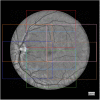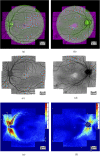Generating large field of view en-face projection images from intra-acquisition motion compensated volumetric optical coherence tomography data
- PMID: 33408968
- PMCID: PMC7747913
- DOI: 10.1364/BOE.404738
Generating large field of view en-face projection images from intra-acquisition motion compensated volumetric optical coherence tomography data
Abstract
A technique to generate large field of view projection maps of arbitrary optical coherence tomography (OCT) data is described. The technique is divided into two stages - an image acquisition stage that features a simple to use fast and robust retinal tracker to get motion free retinal OCT volume scans - and a stitching stage where OCT data from different retinal locations is first registered against a reference image using a custom pyramid-based approach and finally stitched together into one seamless large field of view (FOV) image. The method is applied to data recorded with a polarization sensitive OCT instrument in healthy subjects and glaucoma patients. The tracking and stitching accuracies are quantified, and finally, large FOV images of retinal nerve fiber layer retardation that contain the arcuate nerve fiber bundles from the optic nerve head to the raphe are demonstrated.
Published by The Optical Society under the terms of the Creative Commons Attribution 4.0 License. Further distribution of this work must maintain attribution to the author(s) and the published article’s title, journal citation, and DOI.
Conflict of interest statement
The authors declare no conflicts of interest.
Figures













Similar articles
-
Automatic retinal nerve fiber bundle tracing based on large field of view polarization sensitive OCT data.Biomed Opt Express. 2021 Dec 3;13(1):65-81. doi: 10.1364/BOE.443958. eCollection 2022 Jan 1. Biomed Opt Express. 2021. PMID: 35154854 Free PMC article.
-
Details of Glaucomatous Damage Are Better Seen on OCT En Face Images Than on OCT Retinal Nerve Fiber Layer Thickness Maps.Invest Ophthalmol Vis Sci. 2015 Oct;56(11):6208-16. doi: 10.1167/iovs.15-17259. Invest Ophthalmol Vis Sci. 2015. PMID: 26426403 Free PMC article.
-
Three-dimensional retinal imaging with high-speed ultrahigh-resolution optical coherence tomography.Ophthalmology. 2005 Oct;112(10):1734-46. doi: 10.1016/j.ophtha.2005.05.023. Ophthalmology. 2005. PMID: 16140383 Free PMC article.
-
[Aiming for zero blindness].Nippon Ganka Gakkai Zasshi. 2015 Mar;119(3):168-93; discussion 194. Nippon Ganka Gakkai Zasshi. 2015. PMID: 25854109 Review. Japanese.
-
ZEISS Angioplex™ Spectral Domain Optical Coherence Tomography Angiography: Technical Aspects.Dev Ophthalmol. 2016;56:18-29. doi: 10.1159/000442773. Epub 2016 Mar 15. Dev Ophthalmol. 2016. PMID: 27023249 Review.
Cited by
-
The Development and Clinical Application of Innovative Optical Ophthalmic Imaging Techniques.Front Med (Lausanne). 2022 Jun 30;9:891369. doi: 10.3389/fmed.2022.891369. eCollection 2022. Front Med (Lausanne). 2022. PMID: 35847772 Free PMC article. Review.
-
Identification and quantification of fibrotic areas in the human retina using polarization-sensitive OCT.Biomed Opt Express. 2021 Jun 23;12(7):4380-4400. doi: 10.1364/BOE.426650. eCollection 2021 Jul 1. Biomed Opt Express. 2021. PMID: 34457420 Free PMC article.
-
Growing Trend to Adopt Speckle Variance Optical Coherence Tomography for Biological Tissue Assessments in Pre-Clinical Applications.Micromachines (Basel). 2024 Apr 25;15(5):564. doi: 10.3390/mi15050564. Micromachines (Basel). 2024. PMID: 38793137 Free PMC article. Review.
-
Extending field-of-view of retinal imaging by optical coherence tomography using convolutional Lissajous and slow scan patterns.Biomed Opt Express. 2022 Sep 9;13(10):5212-5230. doi: 10.1364/BOE.467563. eCollection 2022 Oct 1. Biomed Opt Express. 2022. PMID: 36425618 Free PMC article.
-
Toward reliable calcification detection: calibration of uncertainty in object detection from coronary optical coherence tomography images.J Biomed Opt. 2023 Mar;28(3):036008. doi: 10.1117/1.JBO.28.3.036008. Epub 2023 Mar 27. J Biomed Opt. 2023. PMID: 36992694 Free PMC article.
References
Grants and funding
LinkOut - more resources
Full Text Sources
Research Materials
